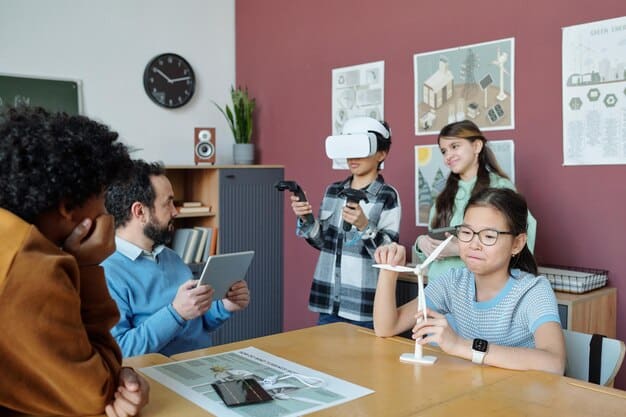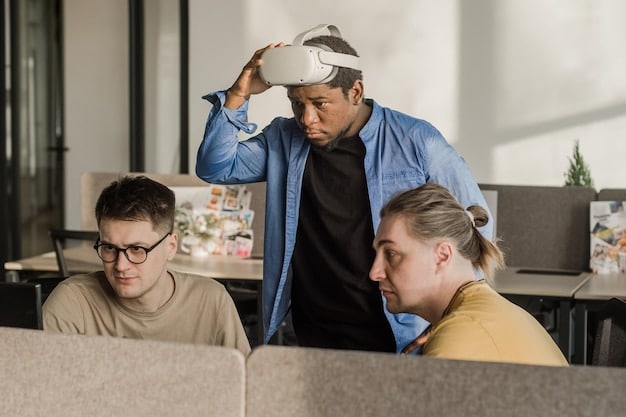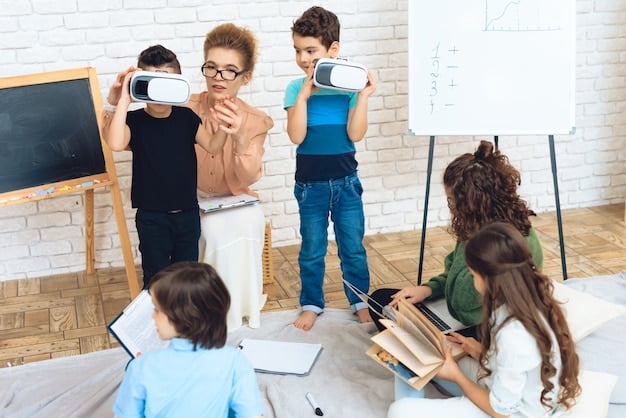Virtual Reality in Education: Effectiveness for STEM Learning in High Schools

Virtual Reality in Education: How Effective is VR for STEM Learning in High Schools? is emerging as a transformative tool, offering immersive experiences that can significantly enhance student engagement, comprehension, and practical skill development in STEM subjects through interactive simulations and virtual field trips.
The landscape of education is constantly evolving, seeking innovative methods to engage students and deepen their understanding. In this quest for pedagogical advancement, Virtual Reality in Education: How Effective is VR for STEM Learning in High Schools? has emerged as a promising frontier. The immersive nature of VR technology offers a unique opportunity to transcend traditional classroom limitations, providing students with experiences previously unimaginable.
The promise of immersive learning environments
The concept of immersive learning environments holds significant promise for transforming how students interact with complex subjects, particularly in STEM fields. Traditional teaching methods, while foundational, can sometimes fall short in conveying the dynamic and multi-dimensional aspects of science, technology, engineering, and mathematics. VR steps in to bridge this gap, offering a sandbox for exploration that is both engaging and effective.
Virtual reality provides a unique platform where abstract concepts can be visualized and manipulated in three dimensions. Consider the intricate structure of a DNA molecule or the complex mechanics of an internal combustion engine; understanding these through static diagrams or lengthy explanations can be challenging. VR allows students to virtually walk within these structures, disassemble and reassemble them, or even observe processes at a microscopic level, fostering a deeper, more intuitive understanding.
Enhancing scientific visualization
Scientific visualization is paramount in many STEM disciplines. VR technology excels here by rendering complex data sets into accessible, interactive 3D models. Students can orbit planets, navigate human anatomy, or witness chemical reactions from a molecular perspective, making abstract theories tangible.
- Exploring simulated environments: Virtual labs and field trips offer safe and accessible alternatives to real-world limitations.
- Manipulating virtual objects: Students can interact with models, conducting experiments impossible or impractical in a traditional lab.
- Understanding complex systems: VR simplifies intricate processes by allowing step-by-step exploration and manipulation.
Boosting engagement and motivation
A key challenge in STEM education is maintaining student interest, especially as topics become more abstract or demanding. VR’s novelty and interactive nature naturally captivate learners. The act of “doing” rather than just “observing” significantly boosts motivation, transforming passive learning into an active, exploratory journey. This increased engagement can lead to better retention of information and a more positive attitude toward STEM subjects.
In summary, the integration of VR into high school STEM education promises a shift towards more dynamic, interactive, and comprehensible learning experiences. By enabling students to visualize and manipulate complex scientific and mathematical concepts in an immersive 3D space, VR not only enhances understanding but also significantly boosts student engagement and motivation, paving the way for a more effective and appealing STEM curriculum. The ability to simulate real-world scenarios and provide hands-on virtual experimentation makes VR an invaluable tool in preparing students for future challenges in science and technology.
Overcoming traditional STEM learning challenges with VR
High school STEM education frequently encounters obstacles that can hinder student comprehension and engagement. These range from the abstract nature of certain concepts to the limitations of physical resources and safety concerns in laboratory settings. Virtual reality offers compelling solutions to these long-standing issues, effectively bridging the gap between theoretical knowledge and practical application.
One of the primary challenges is the difficulty students face in visualizing abstract scientific principles. Concepts such as electromagnetism, quantum mechanics, or cellular biology can be hard to grasp when presented solely through textbooks or 2D diagrams. VR transforms these abstract ideas into immersive, interactive experiences. Imagine students not just reading about atomic structures but virtually constructing atoms, or not merely viewing diagrams of electrical circuits but building and testing them in a risk-free virtual environment. This tactile and visual engagement dramatically improves understanding and retention.
Addressing resource limitations
Many high schools, particularly those in underserved areas, struggle with limited access to expensive lab equipment, rare specimens, or opportunities for real-world field trips. VR bypasses these constraints by providing virtual alternatives. A VR headset can transport students to a simulated molecular biology lab, the surface of Mars, or even inside the human heart, offering experiences that would otherwise be impossible or cost-prohibitive. This democratizes access to high-quality educational resources, leveling the playing field for students regardless of their school’s budget.
- Virtual laboratory experiments: Conduct simulations of chemical reactions or physics experiments without real materials or risk.
- Global field trips: Explore ancient ruins, distant ecosystems, or historical events, expanding cultural and scientific horizons.
- Access to advanced tools: Experience operating complex machinery or scientific instruments not available in a typical school lab.
Enhancing laboratory safety and accessibility
Traditional science labs often pose safety risks, especially when dealing with hazardous chemicals or high-voltage equipment. VR eliminates these dangers entirely, allowing students to conduct experiments that would be too dangerous or impractical in a physical setting. Moreover, VR environments can be adapted to accommodate students with physical disabilities, providing an accessible pathway to hands-on scientific exploration that might otherwise be limited. This inclusive approach ensures that all students can participate fully in experiential learning.
In conclusion, virtual reality presents a powerful toolkit for overcoming many traditional challenges in high school STEM learning. By making abstract concepts tangible, democratizing access to resources, and enhancing both safety and accessibility in practical learning, VR is poised to make STEM education more equitable, engaging, and effective for all students. This technology not only enriches the learning experience but also prepares students with vital skills for future scientific and technological endeavors.
Practical applications of VR in high school STEM classrooms
The theoretical promise of virtual reality in education translates into compelling practical applications within high school STEM classrooms, offering innovative ways to teach and learn across various disciplines. From biology to engineering, VR provides tools that make complex subjects more accessible, engaging, and experientially rich. The implementation of VR experiences can range from detailed simulations to collaborative project-based learning, fundamentally altering the high school learning landscape.
One of the most immediate and impactful applications of VR is in creating virtual laboratory experiences. Instead of relying on potentially costly or hazardous physical equipment, students can perform experiments in a realistic digital environment. Imagine dissecting a virtual frog with unparalleled precision, or conducting chemical titrations without the worry of spills or waste. This hands-on, risk-free approach allows for repeated practice and experimentation, fostering a deeper understanding of scientific methodologies and principles.
Virtual field trips and explorations
Geography, biology, and even physics can be dramatically enhanced through virtual field trips. Students can explore distant ecosystems, visit historical scientific sites, or even navigate the International Space Station, all from their classroom. These immersive journeys provide context and a sense of scale that static images or videos cannot replicate, enriching the learning experience and sparking curiosity about the world around them.
- Historical scientific discoveries: Witness landmark experiments or explore the labs of famous scientists.
- Geological formations: Traverse virtual canyons or explore volcanic caves to understand Earth’s processes.
- Space exploration: Journey through the solar system, landing on planets and moons to study their characteristics.

Design and engineering simulations
For engineering and design courses, VR offers an unparalleled platform for prototyping and testing. Students can design virtual structures, mechanical components, or even robotic systems, then simulate their performance under various conditions. This iterative design process, where students can quickly build, test, and refine their creations, aligns perfectly with modern engineering practices, preparing them for real-world challenges. Such simulations not only develop technical skills but also foster problem-solving abilities and critical thinking.
In summary, the practical applications of VR in high school STEM classrooms are vast and varied, providing impactful tools for virtual laboratory experiments, immersive field trips, and advanced design and engineering simulations. These applications not only enhance the understanding of scientific and mathematical principles but also equip students with critical thinking, problem-solving, and collaborative skills essential for future success in STEM fields. By making learning more interactive and experiential, VR is redefining what is possible in educational settings.
Measuring effectiveness: VR’s impact on STEM learning outcomes
Quantifying the true impact of virtual reality on high school STEM learning outcomes is crucial for justifying its integration and refining its pedagogical applications. While anecdotal evidence often points to increased engagement, rigorous assessment is needed to determine how VR genuinely affects student comprehension, retention, and the development of higher-order thinking skills. Research in this evolving field is beginning to provide valuable insights into VR’s role as an educational enhancer.
Studies are increasingly focused on comparing learning outcomes between traditional teaching methods and VR-enhanced instruction. Initial findings often indicate that students exposed to VR experiences demonstrate better retention of complex information. For instance, students who virtually dissect an organ may recall anatomical details more accurately than those who only study diagrams. This suggests that the immersive, active learning approach facilitated by VR helps solidify knowledge in a way that passive learning methods often cannot.
Enhanced problem-solving and critical thinking
Beyond rote memorization, VR environments provide a rich context for developing problem-solving and critical thinking skills. When students are placed in a virtual scenario where they must diagnose a failed system or conduct a complex experiment, they are compelled to apply their knowledge in a practical, dynamic way. The immediate feedback provided by VR simulations allows for iterative learning, enabling students to understand the consequences of their decisions and refine their approaches quickly. This “learning by doing” within a virtual space is a powerful catalyst for cognitive development.
- Scaffolding complex challenges: VR can guide students through difficult problems, gradually reducing support as they gain proficiency.
- Experimentation with variables: Students can test hypotheses by altering parameters in a virtual environment without real-world constraints.
- Real-time feedback: Immediate results from virtual actions reinforce correct understanding and highlight misconceptions.
Improving spatial reasoning and visualization
Many STEM fields, particularly engineering, physics, and advanced mathematics, demand strong spatial reasoning and visualization abilities. VR, by its very nature, operates in a 3D space, providing an ideal platform for cultivating these skills. Whether students are designing a bridge, mapping out molecular structures, or visualizing force fields, the ability to interact with and manipulate objects in three dimensions directly enhances their spatial cognition. This is a significant advantage over 2D representations, which often require abstract mental transformations.
In conclusion, the effectiveness of VR in high school STEM learning outcomes extends beyond simple engagement, positively influencing knowledge retention, the development of problem-solving and critical thinking skills, and the enhancement of spatial reasoning. As more rigorous research emerges, a clearer picture of VR’s substantial contributions to a robust and effective STEM education continues to form, reinforcing its potential as a transformative educational technology.
Challenges and considerations for VR implementation in high schools
While the potential of virtual reality in high school STEM education is compelling, its widespread implementation is not without significant challenges. Adopting new technologies in educational settings requires careful consideration of various factors, including cost, teacher training, curriculum integration, and technical infrastructure. Addressing these obstacles proactively is essential for successful and equitable deployment of VR.
One of the most prominent barriers to VR adoption is the cost associated with hardware and software. High-quality VR headsets and powerful computers capable of running immersive simulations can represent a substantial investment for school districts, particularly those with limited budgets. Furthermore, the rapid pace of technological change means that hardware can become outdated relatively quickly, necessitating ongoing investment. This financial aspect needs to be weighed against the perceived educational benefits and integrated into long-term budget planning.
Teacher training and curriculum integration
Even with the right hardware, VR is only as effective as the educators who wield it. Teachers require comprehensive training not only in operating the VR equipment but also in pedagogical strategies for integrating VR experiences seamlessly into the existing curriculum. This involves understanding how to leverage VR to meet learning objectives, manage virtual classroom environments, and assess student performance within immersive contexts. Without adequate training, VR might be underutilized or misused, becoming a novelty rather than a truly transformative tool.
- Developing tailored lesson plans: Creating activities that fully exploit VR’s unique capabilities.
- Managing virtual classroom dynamics: Strategies for overseeing students in individual VR experiences.
- Assessing learning in VR: New methods for evaluating understanding and skill development in virtual environments.

Technical infrastructure and maintenance
Implementing VR also demands robust technical infrastructure. Schools need reliable, high-speed internet connectivity to download VR applications and updates, as well as sufficient network bandwidth to support multiple users simultaneously. Managing and maintaining the VR equipment, including charging, cleaning, and troubleshooting, adds another layer of complexity. Schools must consider dedicated IT support or training for staff to handle these technical aspects, ensuring that the technology is consistently available and functioning properly.
In summary, while virtual reality offers immense potential for enhancing high school STEM education, its successful implementation requires careful planning and investment to overcome challenges related to cost, teacher training, curriculum integration, and technical infrastructure. Addressing these considerations will pave the way for a more seamless and impactful adoption of VR, ensuring that it serves as a valuable asset rather than just an expensive gimmick in the pursuit of enriched learning experiences.
Future outlook: scaling VR in STEM education and fostering innovation
The future of virtual reality in STEM education for high schools appears promising, with the potential for widespread adoption as technology matures and costs decrease. Scaling VR solutions beyond pilot programs into mainstream curricula will require continued innovation, strategic partnerships, and a clear vision for how immersive technologies can best serve educational goals. The trajectory suggests an evolution from novelty to an indispensable tool for preparing students for a tech-driven future.
As VR hardware becomes more affordable and accessible, and as software developers create more compelling and educationally sound content, the barriers to entry for schools will diminish. This reduction in cost, coupled with improved user interfaces and more robust educational applications, will make VR a more viable option for a greater number of high schools, fostering a new era of immersive learning experiences across diverse socioeconomic backgrounds.
The role of content development and collaboration
The true power of VR in education lies in its content. The development of high-quality, curriculum-aligned STEM experiences is paramount. This will involve collaboration among educators, VR developers, and subject matter experts to create scenarios that are not only engaging but also pedagogically effective. Open-source platforms and shared content libraries could further accelerate adoption, allowing schools to access a wealth of resources without excessive individual development costs.
- Interactive curriculum modules: Designing VR experiences that integrate directly into existing lesson plans.
- Assessment tools within VR: Developing ways to evaluate student progress and comprehension in immersive environments.
- Personalized learning pathways: Utilizing VR to adapt learning content and pace to individual student needs.
Preparing students for future careers
Beyond enhancing current learning, VR in STEM education plays a crucial role in preparing high school students for future careers. Many industries, from medicine and engineering to advanced manufacturing, are increasingly adopting VR and augmented reality (AR) for training, design, and operational tasks. By engaging with VR in their formative years, students gain valuable exposure and proficiency with technologies that will be commonplace in their professional lives, making them more competitive in the evolving job market.
In conclusion, the future outlook for virtual reality in high school STEM education is bright. As technology becomes more accessible, and as innovative educational content is developed through collaborative efforts, VR is poised to transform the learning landscape. By fostering deep engagement, critical thinking, and familiarity with emerging technologies, VR will not only enhance current educational outcomes but also effectively prepare students for the demands and opportunities of tomorrow’s workforce, solidifying its place as a cornerstone of modern STEM pedagogy.
Ethical considerations and equitable access in VR education
As virtual reality becomes an increasingly potent tool in high school STEM education, it is imperative to address the ethical considerations and ensure equitable access for all students. The promise of transformative learning must be balanced with careful thought regarding potential pitfalls, guaranteeing that VR enhances education universally, rather than exacerbating existing disparities or posing unforeseen challenges.
One core ethical consideration revolves around data privacy. VR systems, especially those that track eye movements, gestures, or even biometric responses, collect a vast amount of potentially sensitive student data. Schools must implement robust policies regarding data collection, storage, and usage, ensuring that student privacy is protected and that data is used solely for educational purposes, adhering to strict compliance regulations. Transparency with students and parents about data practices is paramount to building trust.
Addressing digital divides and accessibility
Equitable access is a significant concern. The digital divide, marked by disparities in access to technology and internet connectivity, could widen if VR integration is not managed carefully. Schools in underserved communities might struggle to afford VR hardware or the necessary infrastructure, leaving their students behind in terms of access to these advanced learning tools. Strategies must be developed to bridge this gap, potentially through government funding, non-profit initiatives, or creative community partnerships, ensuring that VR is available to all students regardless of their socioeconomic background.
- Subsidized hardware programs: Government or philanthropic initiatives to reduce the cost burden on schools.
- Community VR hubs: Establishing shared VR facilities accessible to multiple schools.
- Developing low-cost VR solutions: Encouraging the creation of more affordable, yet effective, VR educational tools.
Content bias and potential for addiction
The content developed for VR educational experiences also requires scrutiny for potential biases. VR developers must ensure that simulations and narratives are inclusive, culturally sensitive, and free from stereotypes. Moreover, while VR offers immersive learning, there’s a need to balance screen time and prevent over-reliance or potential addiction, particularly for adolescents. Educational institutions must establish clear guidelines for VR usage, promoting its role as a supplementary tool rather than a replacement for diverse learning activities.
In conclusion, while virtual reality offers transformative possibilities for high school STEM education, its implementation demands a proactive approach to ethical considerations and equitable access. Safeguarding student data privacy, actively working to bridge socioeconomic digital divides, and ensuring diverse and balanced content are crucial steps. By addressing these challenges thoughtfully, the educational community can harness the full potential of VR to create a genuinely inclusive, enriching, and responsible learning environment for all students.
Empowering educators for the VR frontier
The successful integration of virtual reality into high school STEM education ultimately hinges on the empowerment of educators. Teachers are the frontline facilitators of learning, and their ability to effectively utilize and integrate VR technology will determine its true impact. This involves providing them with the necessary training, resources, and ongoing support to navigate this new educational frontier confidently.
Beyond basic technical proficiency, empowering educators means fostering a deeper understanding of VR pedagogy. Teachers need to learn how to design lessons that maximize VR’s unique strengths, understand how to manage a classroom where students might be immersed in individual virtual experiences, and develop new strategies for assessing learning outcomes in these dynamic environments. This pedagogical shift requires tailored professional development programs that go beyond one-off workshops, offering continuous learning and peer collaboration opportunities.
Building a supportive infrastructure for teachers
To truly leverage VR, teachers require more than just training; they need a robust support system. This includes readily available technical assistance for troubleshooting hardware and software issues, access to a curated library of high-quality educational VR content, and platforms for sharing best practices and innovative lesson plans with colleagues. A collaborative community of practice can significantly reduce the isolation some educators might feel when adopting new technologies, fostering a sense of shared learning and problem-solving.
- Dedicated IT support for VR: On-demand assistance for technical glitches and setup.
- Curated content repositories: Easy access to vetted, curriculum-aligned VR applications.
- Professional learning communities: Forums and workshops for sharing insights and strategies among educators.
Fostering innovation and experimentation
Empowering educators also means giving them the autonomy and encouragement to experiment with VR in their classrooms. A culture that embraces innovation, allows for iterative improvements, and values teacher-led initiatives will lead to more creative and effective uses of VR. Providing opportunities for teachers to prototype their own VR-enhanced lessons, share their findings, and even contribute to the development of new educational tools can accelerate the adoption and refinement of VR in STEM education.
In conclusion, the journey to effectively integrate virtual reality into high school STEM education is inherently tied to empowering educators. By investing in comprehensive pedagogical training, establishing robust support infrastructures, and fostering a culture of innovation and collaboration, schools can equip teachers with the skills and confidence needed to unlock VR’s full potential. This empowerment will not only enhance the learning experience for students but also elevate the role of educators as pioneers in the evolving landscape of 21st-century education.
| Key Aspect | Brief Description |
|---|---|
| 🔬 Immersive Learning | VR transforms abstract STEM concepts into engaging, interactive 3D experiences, significantly boosting comprehension. |
| 🔗 Practical Applications | Enables virtual labs, field trips, and design simulations, overcoming resource limitations and safety concerns. |
| 📈 Learning Outcomes | Shown to enhance retention, problem-solving, critical thinking, and spatial reasoning in students. |
| ⚖️ Challenges & Ethics | Addresses costs, teacher training, equitable access, and data privacy for successful, responsible integration. |
Frequently Asked Questions About VR in STEM Education
▼
VR enhances understanding by allowing students to visualize and interact with complex 3D models and simulations. For instance, instead of static images, students can virtually dissect a human heart or explore molecular structures, manipulating them directly. This active, immersive engagement makes abstract concepts tangible and more intuitive, leading to deeper comprehension and better long-term retention of difficult material.
▼
The main logistical challenges include the significant upfront cost of VR hardware and software, the need for robust technical infrastructure like high-speed internet, and providing adequate teacher training. Additionally, ongoing maintenance of equipment and integrating VR content seamlessly into existing curricula without disrupting normal operations can be complex for school administrations.
▼
While VR offers excellent virtual lab simulations that are safe, cost-effective, and provide broad access, it’s generally seen as a powerful supplement rather than a complete replacement for traditional lab experiments. The tactile experience, handling of real materials, and unexpected variables of physical experiments offer unique learning opportunities that VR cannot fully replicate. A blended approach leveraging both is often considered ideal.
▼
VR prepares students for STEM careers by familiarizing them with technologies increasingly used in industries like medicine, engineering, and manufacturing for design, training, and simulation. Engaging with VR builds critical skills such as spatial reasoning, complex problem-solving, and digital literacy. It also offers exposure to realistic professional scenarios, giving students a practical edge in a rapidly evolving job market.
▼
Key ethical considerations include student data privacy, as VR systems collect detailed interaction data, and ensuring equitable access to prevent widening the digital divide for underserved communities. Concerns also encompass potential content biases in simulations and the need to manage screen time to avoid over-reliance on virtual environments. Schools must implement clear policies to address these issues responsibly.
Conclusion
The integration of virtual reality into high school STEM education stands as a compelling advancement, offering transformative potential to overcome traditional learning challenges and cultivate deeper engagement. While hurdles related to cost, training, and equitable access remain, the proven capacity of VR to enhance comprehension, foster critical thinking, and prepare students for future tech-driven careers solidifies its position as a valuable, evolving educational tool. Strategic implementation, coupled with ongoing innovation and a focus on empowering educators, will pave the way for VR to unlock new dimensions in STEM learning, ultimately benefiting a wider array of students and shaping a more dynamic educational future.





